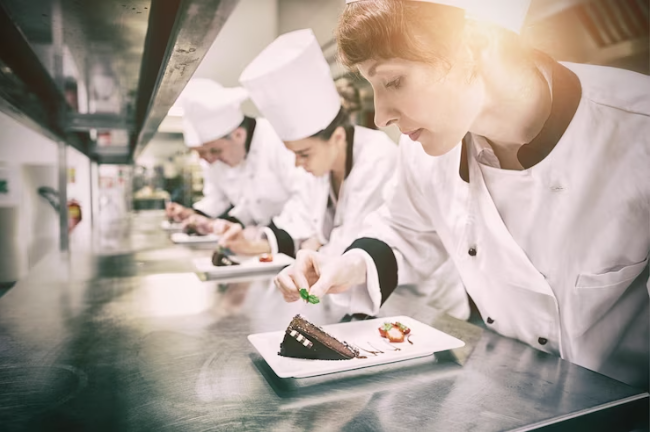Are you tired of your restaurant’s kitchen constantly being in chaos during the busiest hours of the day? Do you struggle to keep up with orders and ensure that food is delivered to customers in a timely manner?
If so, consider implementing kitchen workflow optimization techniques to enhance your restaurant’s efficiency. Kitchen workflow optimization involves analyzing your restaurant’s kitchen processes, reorganizing the kitchen layout, optimizing equipment usage, and adjusting the menu for efficiency.
By implementing these techniques, you can reduce wait times, increase productivity, and improve the overall dining experience for your customers. In this article, we will explore the benefits of kitchen workflow optimization and provide tips on how to successfully implement these techniques in your restaurant.
Benefits of Kitchen Workflow Optimization
Optimizing your kitchen workflow can bring a plethora of benefits, like increasing productivity and reducing wait times, making your restaurant run like a well-oiled machine.
Implementing an efficient workflow can help your restaurant measure ROI and improve customer satisfaction. When your kitchen operates seamlessly, your staff can serve more customers in less time, which can translate into increased revenue and a higher ROI.
An optimized kitchen workflow can also lead to happier customers. When guests enter your restaurant, they expect quick service and delicious food. By streamlining your kitchen processes, you can reduce wait times and ensure that orders are fulfilled accurately and promptly.
This can lead to higher customer satisfaction rates and positive reviews, which can ultimately help your restaurant grow and thrive.

Analyzing Kitchen Processes for Optimization
You can picture the chaos in the kitchen as cooks rush to prepare orders, but have you ever considered how analyzing kitchen processes can lead to smoother operations? By taking a closer look at each step in the preparation process, you can identify areas where time and resources are being wasted.
This analysis can lead to streamlining preparation, reducing waste, and ultimately, increasing efficiency. One common area for optimization is ingredient preparation. Are all ingredients being prepped in a way that maximizes efficiency? Are there tools or techniques that could be used to speed up the prep process?
By examining these questions, you can identify ways to reduce the time and effort needed for ingredient preparation. This not only saves time but can also reduce the risk of waste due to over-prepping or spoilage. Analyzing kitchen processes may seem tedious, but the benefits of increased efficiency are well worth the effort.
Reorganizing the Kitchen Layout
If you’re feeling overwhelmed in the kitchen, consider taking a step back and examining the layout. Maximizing space and reducing clutter can greatly improve efficiency.
Begin by identifying areas of the kitchen that aren’t being used to their full potential. Are there unused corners or awkward spaces that could be better utilized? Look for ways to consolidate equipment and supplies to free up more space.
Another important factor to consider is streamlining food flow and improving speed. This can be accomplished by placing equipment and supplies in logical locations that minimize the distance between stations. For example, placing the grill and fryer next to each other can save time and reduce the number of steps required to prepare a dish.
Additionally, grouping ingredients and tools together can reduce the time it takes to retrieve them during food preparation. By taking the time to reorganize the kitchen layout, you can greatly enhance your restaurant’s efficiency.
Optimizing Equipment Usage
Get the most out of your kitchen equipment by using them in creative and versatile ways. One way to optimize equipment usage is by regularly maintaining them. Neglecting equipment maintenance can lead to frequent breakdowns and costly repairs, which can disrupt kitchen operations.
Make sure to schedule regular maintenance checks for your equipment to ensure that they’re running smoothly and efficiently. Additionally, train your staff on how to properly use and care for the equipment to prevent any mishandling or accidents.
Aside from maintenance, you can also optimize equipment usage by training your staff on how to use them in different ways. For example, a stand mixer can be used not just for mixing dough but also for shredding cooked meat or vegetables. A food processor can be used for making sauces, dips, and even desserts.
By utilizing your equipment in multiple ways, you can reduce the need for additional equipment, which can save you money and space in the kitchen. With proper maintenance and staff training, you can get the most out of your equipment and enhance the efficiency of your restaurant’s kitchen workflow.
Adjusting the Menu for Efficiency
When planning your menu, it’s important to consider which dishes can be prepared quickly and efficiently to help streamline kitchen operations. This process is known as menu engineering, and it involves analyzing the profitability and popularity of menu items to determine which ones are worth keeping and which ones can be removed or modified.
By focusing on dishes that can be prepared quickly and with minimal ingredient sourcing, you can ensure that your kitchen staff can work efficiently and minimize the risk of delays or mistakes. Menu engineering can also help you keep your costs under control by identifying which dishes are the most profitable and which ones may be costing you money.
By analyzing the costs of ingredients, prep time, and cooking time, you can make informed decisions about which dishes to keep, modify, or remove from your menu. This can help you optimize your kitchen workflow and improve your bottom line, while still providing your customers with delicious and satisfying meals.
So if you want to enhance your restaurant’s efficiency, start by taking a closer look at your menu and making the necessary adjustments. https://ivorymagazine.com/restaurant-catering-program/
Frequently Asked Questions
What is the cost associated with implementing kitchen workflow optimization?
You can expect some training costs and implementation challenges when optimizing your kitchen workflow. However, conducting an ROI analysis beforehand can help you determine if the benefits outweigh the budget constraints.
How long does it typically take to see a noticeable improvement in efficiency after implementing workflow optimization?
Measuring the effectiveness of workflow optimization depends on factors such as current processes and staff training. Tracking progress can be done through data analysis. Improvement can typically be seen within a few weeks to a few months.
What are some potential challenges or drawbacks to reorganizing the kitchen layout?
When reorganizing the kitchen layout, space limitations may pose a challenge. Additionally, staff resistance to change could hinder the process. However, with proper planning and communication, these issues can be overcome.
Are there any specific types of equipment that are particularly effective in optimizing kitchen workflow?
To optimize kitchen workflow, equipment selection and workflow analysis are crucial. Look for versatile tools that can handle multiple tasks and streamline processes. Consider investing in automated or digital equipment to reduce human error and save time.
How can restaurant staff be trained to effectively implement and maintain optimized kitchen processes and workflow?
To effectively implement and maintain optimized kitchen processes and workflow, staff training is crucial. Implementation techniques such as hands-on training, clear communication, and continuous improvement can help ensure successful adoption and adherence to new processes.
Conclusion
In conclusion, optimizing your restaurant’s kitchen workflow can lead to numerous benefits. You can increase efficiency, reduce wait times, and improve customer satisfaction. By analyzing your kitchen processes, reorganizing the layout, optimizing equipment usage, and adjusting the menu, you can streamline your restaurant’s operations and create a more efficient and profitable business.
Remember to constantly evaluate and adjust your kitchen workflow to ensure that it continues to meet your restaurant’s needs and goals. By implementing these strategies, you can enhance your restaurant’s efficiency and provide a better dining experience for your customers.
So, take the time to invest in your kitchen workflow, and watch as your restaurant thrives.



